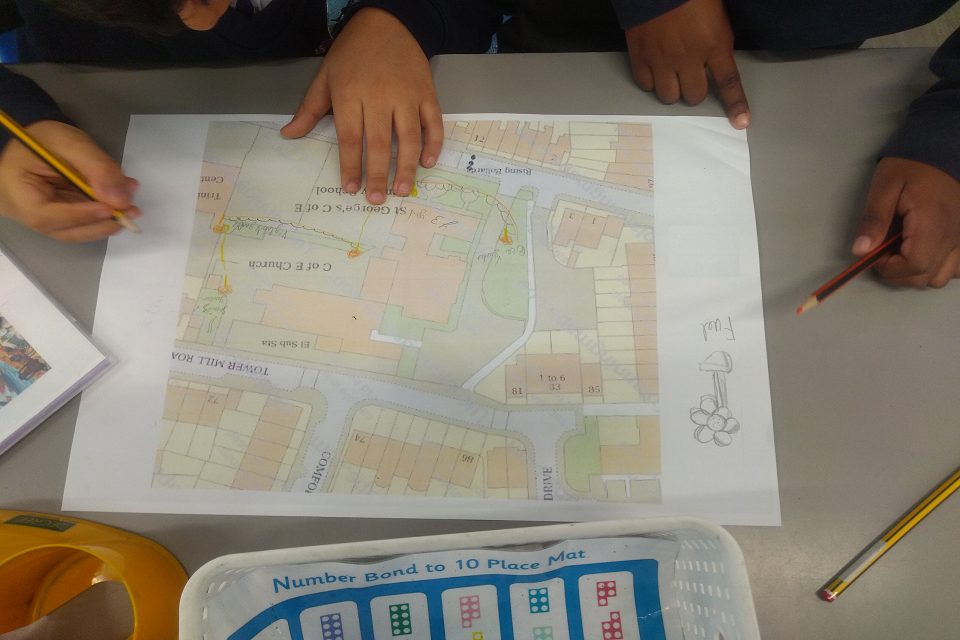Bee corridors
Find out about bee corridors, why bees need them to travel from place to place and how you can help to create a bee corridor near you.
03 April 2023

Explore the meaning behind the words in bold in our glossary at the bottom of this page.
What are Bee Corridors?
Bee corridors are areas of nectar-rich flowering plants that bees and other pollinators travel through, providing them with the nectar they need to fly to their next habitat patch. The diagram above shows how the flowering plants at the school help to create a corridor, which bees can travel along, finding food as they fly from one habitat patch to another.
Why are they needed?
As the number of people on the planet increases, we are taking up more space to live so there is less and less habitat available for wildlife, including bees and other pollinating insects.
The habitat that is left is often in small patches separated from other patches of habitat by roads and buildings. This can make it very difficult for pollinators to move from one habitat area to another to find the flowers that they need to feed on, to find a mate or to find a nesting site.
By planting nectar-rich flowering plants wherever we can, we can create corridors for bees and other pollinators to move along.
.png)
Image: Pots for pollinators (Credit: RHS Georgi Mabee)
How much bee energy can a plant provide?
By planting the right kinds of plants this can soon add up to a lot of bee miles travelled. For example, one snapdragon plant can provide a bumblebee with enough energy to fly 10-13 miles a day.
.png)
Image: Snapdragon plant (Credit: Paul Debois)
Snapdragon tips
How can we help bees?
1. Add more flowers
Help to create a bee corridor by planting some flowering plants around your school, not only will they provide nectar for pollinators and help to create corridors for them to travel along, your school will look lovely too!
.png)
Image: Help to create a bee corridor by planting nectar-rich flowers for pollinators (Credit: RHS Joanna Kossak)
You can find more inspiration here:
Container planting
Bumblebee planters
2. Plant for pollinators
To find other plants that are best for pollinators, look to see if there is an RHS Plants for pollinators logo (see photo) when you buy a plant or packet of seeds. You can find out more about this along with a list of easy plants to grow for pollinators here.
.png)
Image: Plants for pollinators logo (Credit: RHS Joanna Kossak)
3. Provide water
Put out shallow dishes of water with stones for insects to crawl down so that they can drink.
4. Let grass grow
Allow areas of grass to grow long, encouraging flowers such as dandelions to appear, dandelion flowers are fantastic sources of nectar for pollinators.
The Bee Garden at St George’s Primary School
The pupils in year 3 at St George’s Primary School, Camberwell, spent a morning looking at their school grounds to see how they could help bees to travel from the reception playground, where there are lavender and rosemary bushes, to the Bee Garden where there are plenty of flowers to feed on. The children used maps of the school to plot the best spots to plant flowers for bees to refuel with nectar. Some included the community orchard outside the school grounds in their maps.

Image: St George’s Primary pupils map out the places where bees can refuel with nectar in and around their school (Credit: St George's Primary School)
They also had a look at the flowers already blooming at school that bees could feed on:
.png)
Image: Spring flowers at St George’s which bees can feed on while moving between habitat patches (Credit: St George's Primary School)
We’d love to hear how you have helped bees. Tag us in your photos on Facebook, Instagram and Twitter.
Glossary
|
Corridor
|
Allows movement from one place to another (an area which links two other areas together).
|
|
Habitat
|
A home for plants and animals.
|
|
Mate
|
The sexual act of a male and female individual of a species coming together to breed.
|
|
Nectar
|
Sweet liquid mainly produced in flowers.
|
|
Pollinating
|
Animals moving pollen from one flower or plant to another e.g. bees.
|
|
Pollinators
|
Animals that move pollen from one flower or plant to another e.g. bees.
|
Find out more about bees
If you are just buzzing to find out more about bees, check out our monthly updates:
Learn more about pollinators:
September update
Find out more about pollen:
October update
What happens to bees in the colder months?
November update
How many types of bees are there in the UK?
December update
Discover how bees help put the food on your plate:
January update
Explore the lifecycle of a bumblee:
February update
What to sow to help bees in June:
March update